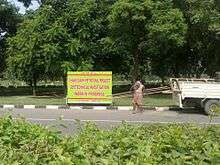Chandigarh Metro
| Overview | |
|---|---|
| Locale | Chandigarh, India |
| Transit type | Rapid Transit |
| Number of lines | 2 |
| Number of stations | 30 |
| Daily ridership | 300,000 (estimated) |
| Operation | |
| Operation will start | 2018 |
| Operator(s) | Chandigarh Metro Rail Corporation (CMRC)[1] |
| Number of vehicles | 16 |
| Train length | 4 coaches |
| Technical | |
| System length | 37.573 km |
| Electrification | N/A |
Chandigarh Metro is a proposed rapid transit system for the city and union territory of Chandigarh in India.[2][3][4]
History
Delhi Metro Rail Corporation (DMRC) submitted the detailed project report of the Chandigarh Metro Project to Punjab Governor and UT administrator Shivraj Patil on 16 August 2012.[5]

On 9 July 2015, in the presence of Kaptan Singh Solanki, who is the Governor of Punjab and Administrator of Chandigarh as well as the Governor of Haryana, the MoU was signed by the Additional Chief Secretary, Haryana Town and Country Planning Department, P Raghavendra Rao, the Secretary, Town and Planning, Punjab, A Venu Prasad, and the UT Adviser, Vijay Kumar Dev.[6] As part of the MoU, the three parties also named the special purpose vehicle (SPV) to execute the project as the Greater Chandigarh Transport Corporation (GCTC) for the development of comprehensive integrated multi-modal urban and sub-urban commuter system for the region. The initial equity of the GCTC shall be Rs 100 crore, which will be contributed equally — 25 per cent each — by the Union Ministry of Urban Development, the UT Administration, Haryana and Punjab.[7]
Plan
In the first phase, a 37.573 km metro rail network will be built of which 23.468 km will be elevated and 14.105 km underground Corridor. It will run from north to south. It will start near Capitol Complex and will go up to Mohali. Corridor II, also known as East West Corridor, will start from Sector 21, Panchkula and reach up to Mullanpur.[8][9]
Routes
The proposed routes for the various corridors of the metro network are as follows:
- Corridor 1: Khuda Lahora to IT Park via Punjab University, PGI, Government College, General Hospital, Sector 17- Interchange, Sector 8, Sector 7, Sector 26, Grain Market, Transport Nagar, Chandigarh Railway Station, Manimajra, covering a distance of approximately 16.00 km.
- Corridor II: Sectt. Sector 1 Chandigarh to Bus terminal Sector 104 S.A.S Nagar, Mohali, via Rock Garden, Sector 9, Sector 17 interchange, Sector 17 ISBT, Sector 22-Aroma Hotel Sector 34, Bus Terminal Sector 43, Sector 52, Mohali Sector 62, Sector 60, Sector 72, Sector 71, Sector 75, Sector 76, Sector 77, Sector 78, Sector 87, Sector 97, Sector 106, Sector 105 covering a distance of 22 km.[10]
- Corridor III : Timber Market Chowk Sector 26 to Sector 38 and Dadu Majra along Purv Marg and Vikas Marg covering a distance of approximately 14.6 km.
- Corridor – IV: Housing Board Chowk to Sector 21 Panchkula, via Panchkula Sector 17,16,15,14, & 21 covering a distance of 5 km.[11]
Cost
The project is expected to cost ₹113.75 billion (US$1.7 billion), out of which ₹89.95 billion (US$1.3 billion) will be borne by Chandigarh Administration, ₹16.8 billion (US$250 million) will be borne by Punjab Govt. and the remaining ₹7 billion (US$100 million) by Haryana Govt. The expected cost of the metro elevated section is ₹1.4 billion (US$21 million) per Km and that of the metro underground section is ₹3.5 billion (US$52 million) per Km. The metro will be completed in two phases. The estimated cost of Phase-I is ₹89.95 billion (US$1.3 billion) and that of Phase-II is ₹23.8 billion (US$350 million).[12]
Vision
The vision behind the metro system is a well contained city with efficient people friendly transport system with minimum travel time & maximum safety and comfort. The main points of the envisaged vision are:
- To improve connectivity and travel throughout the city and its region.
- To improve mobility within neighborhoods, wards, zones and satellite towns to address inner- and inter-city transportation needs.
- To achieve efficient arrangement of land use and transport systems to minimize overall travel cost.
- To offer viable and reliable transportation options that aim at reducing dependence on cars, with widespread use of non-motorised modes and mass rapid transit system.
See also
References
- ↑ Vibhor Mohan (30 August 2012). "Chandigarh Metro Rail Corporation to have independent mandate – Times of India". Articles.timesofindia.indiatimes.com. Retrieved 2012-12-14.
- ↑ Punjab, Haryana, Chandigarh set to sign agreement on tricity Metro project Archived 14 July 2014 at the Wayback Machine.
- ↑ http://admser.chd.nic.in/uploadfiles/press/pressnote/pr2607.pdf
- ↑ http://www.railnews.co.in/chandigarh-metro-project-will-not-be-financially-viable-till-2051-due-to-low-phpdt/
- ↑ "DMRC presents Chandigarh Metro Project DPR to Shivraj Patil". Hindustan Times. 17 August 2012. Retrieved 2012-12-14.
- ↑ Ajay Deep. "Vijay Kumar Dev, UT Advisor signs Chandigarh Metro MOU".
- ↑ "Finally, tricity gets Metro on track UT, Haryana, Punjab sign memorandum of understanding on integrated mass transport system". The Tribune. 10 July 2015.
- ↑ Vibhor Mohan (21 July 2012). "Chandigrah to get 16 trains in 2018 – Times of India". Articles.timesofindia.indiatimes.com. Retrieved 2012-12-14.
- ↑ Mahendra Kumar Singh (17 January 2008). "Chandigarh set for a Metro ride". The Times of India. Retrieved 2010-08-16.
- ↑ Ajay Deep. "Chandigarh Metro Route Map".
- ↑ http://chandigarh.gov.in/advt/cmp-mrts100809.pdf
- ↑ Ajay Deep. "Chandigarh Metro Project Cost & Other Details".